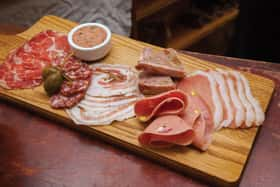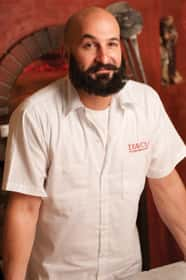Stemming back some 6,000 years, charcuterie—the art and tradition of preserving meats—has a long history, becoming popular during the Roman Empire and perfected in France during the Middle Ages. “Charcuterie” comes from the French term chair cuit, literally meaning “cooked flesh,” and used to refer only to products made from pork. After charcutiers began experimenting with different kinds of meat and poultry, the word charcuterie expanded to describe any meat product that’s cured, smoked or preserved using traditional methods, even ones made from poultry or seafood.
The art and science of charcuterie became more sophisticated and creative over the last several centuries in France, but the appeal has remained the same, resulting in the products and processes spreading to neighboring regions such as Spain, Italy and Germany. Each country developed its own custom style and unique flavors, from Genoa salami in Italy to bratwurst in Germany. Over time, the art and tradition emigrated to the United States and various states started to specialize in their own charcuterie delicacies, from sausages in Pennsylvania to cured and smoked hams in Virginia. Today, classic charcuterie items include sausages, pâtés, terrines and confit, but even familiar smoked or cured meats such as ham and bacon are technically within the realm of charcuterie.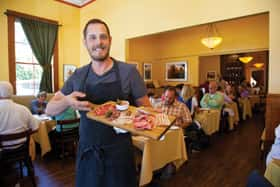

Much of the charcuterie in this country evolved from a specialized art to a common and almost mundane item. Bologna, for example, a sausage derived from the Italian mortadella and originating from Bologna, Italy, has been reduced in this country to a cheap lunchmeat primarily used as a staple in school lunch boxes. However, over the last few decades, the art of charcuterie has witnessed a revived passion—both on the part of chefs and sausage makers (sometimes referred to as “salumists”), as well as for consumers who have a growing desire to know what’s in their food, where it came from and how it was produced.
“What makes this area so unique is that there’s no stopping point of satisfaction,” says John Toulze, managing partner and executive chef of Sonoma-based the girl and the fig, and Suite D, which produces a plethora of housemade charcuterie. “What we’ve really enjoyed and what you also see in the consumer, is there’s no point when someone just goes ‘Wow, they make their own pancetta!’” he says.
“From there, the questions start to become, ‘Where are you getting the animal from?’ ‘How was it raised?,’ and so on. You can keep going back and further up that chain of ingredients and, the questions are really about, not only if it’s made locally, but are the ingredients produced locally, are they produced right, are they ethical—the whole thing. There’s just an awareness and caring about the products that I haven’t experienced in other areas.”
More than meats the eye
While the original reasons for making charcuterie products were based on minimizing food spoilage in an era before refrigeration, and on not wasting any part of the animal that could be used for food (and profits), today’s chefs are all about producing a superior product that’s unlike anything one can find on the standard grocery shelf. From intimately knowing the source of their ingredients, including meeting the farmers and understanding how the animals are raised and fed, to actually producing the products, charcuterie chefs are like artists using meats as their canvas.
Consumers are clearly recognizing the difference in taste between regular grocery aisle charcuterie products and these artisan producers because demand, even with higher prices, has significantly increased over the last several years. It’s this demand-driven niche that’s caused several high-end restaurants to produce their own charcuterie.
“We make everything now—every piece of bacon, every piece of pancetta, every slice of ham, every piece of salami—we make it all in-house,” says Toulze. “For us, it’s become less of an item on its own. If I want to do something with Mortadella, instead of thinking ‘Who should I get that from?’ I’ll make it. When we add an aioli to something, we don’t buy mayonnaise and add it to the recipe, we make it from scratch. Instantly, you’ve improved its quality.”
Making ends meat
With increased demand comes increased competition. As a result, more and more restaurants are not only making their own charcuterie, but many also getting licenses to sell their products both direct to consumers to take home as well as to other retailers and restaurants. Yet for now, demand still seems to surpass supply, and there’s still room in the marketplace for more artisan charcuteries. As is the case with many artisan food producers, the industry is encouraging and welcoming of new faces, resources, advice and suggestions are freely given. With so many different styles and tastes, there really is a niche for everyone.
“I think there’s room for everybody,” says Dino Bugica, chef owner of Diavola Pizzeria and Salumeria in Geyserville. “The more the merrier. I enjoy working with other chefs, and [competition] hasn’t hurt our business.”
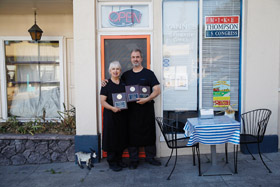 Francesca Vrattos, co-owner of Yanni’s Sausage Grill in Penngrove (with husband John Vrattos), whose sausages were awarded Best of Charcuterie from the Sonoma County Harvest Fair in 2010, 2011 and 2012, agrees.
Francesca Vrattos, co-owner of Yanni’s Sausage Grill in Penngrove (with husband John Vrattos), whose sausages were awarded Best of Charcuterie from the Sonoma County Harvest Fair in 2010, 2011 and 2012, agrees.“Competition hasn’t affected us, because there are so many people interested in charceuterie that there’s a large enough customer base to go around,” Vrattos says. “There’s going to be competition, but it’s healthy. It makes us step up and be even better and introduces more people to the product.”
Vrattos recounts a time near the start of the business when she and her husband, John, met Chef Bruce Aidell, whom they had admired for some time, at a book signing. He graciously answered their questions about their business plan, recipe development and how to multiply recipes for their growing base of customers.
This sharing of information is another factor that’s resulted in more and more chefs creating their own charcuterie. With more books, classes and online information available about the subject than ever before, chefs are increasingly intrigued with curing and preserving their own meats.
“The more people [creating artisan charcuterie], the better it gets—for makers and consumers,” says David Katz, managing partner of Panevino, Food for Wine, which produces charcuterie products under its Sub Rosa Salumi label. “There are plenty of people curing in the North Bay. It’s a noncompetitive community and we get together from time to time. We taste, talk and help each other.”
Education is key
With some artisan charcuteries charging double what consumers can find in a traditional grocery store, there’s certainly some education taking place on behalf of the producers, to get customers to understand the ingredients, process and time it takes to deliver these items to their plates. While consumers no doubt can taste the superiority of a hand-made product over a manufactured one, salumists nevertheless enjoy telling their customers about their craft.
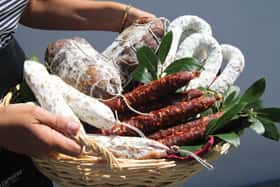 “Most consumers don’t know, even if they’re aficionados, that salamis and other cured sausages are fermented,” explains Katz. “You don’t just mix it up, press it like a fresh sausage and hang it in a chamber to dry. You have to ferment. We add specific strains of bacterial culture, like a winemaker might add yeast. The freshly pressed salumi goes into a warm, 99 percent humidity environment—a fermentation chamber, for up to four days.”
“Most consumers don’t know, even if they’re aficionados, that salamis and other cured sausages are fermented,” explains Katz. “You don’t just mix it up, press it like a fresh sausage and hang it in a chamber to dry. You have to ferment. We add specific strains of bacterial culture, like a winemaker might add yeast. The freshly pressed salumi goes into a warm, 99 percent humidity environment—a fermentation chamber, for up to four days.”This fermentation process, while adding to the complexity of aroma and flavor (as in the artisan wine or cheese industries), also does something critical in terms of safety: The bacteria converts sugars into lactic acid, which offers the first protection in keeping bad bacteria from growing, causing spoilage and food-borne illnesses. Afterward, the product is dried, for weeks to months, in a separate temperature- and humidity-controlled chamber to achieve proper texture, flavor and a shelf-stable water activity. Many off-the-shelf, supermarket salamis aren’t fermented or, at most, are fermented very little. Instead, as a short cut, something acidic, like Vitamin C or lactic acid, is added to ensure safety and lend a tangy flavor—but at the loss of taste and aroma complexity.
“I don’t think [consumers] realize the time it takes to make some of these products,” says Toulze. “Even our small salamis take two to three months. The bigger ones take three to four months, start-to-finish. The idea with food is that it’s fresh and it’s instant: You get it now. But with charcuterie and curing, the opposite is true.”
For Stewart, whose prosciutto can hang for up to two years before it’s ready to be served, charcuterie is one industry where faster isn’t better, and new ways of producing isn’t necessarily an improvement.
“People always want to fix things and make them better,” says Stewart. “I think a lot of these products are great. They don’t need improvement, they just need to be respected.”
Until we meat again
If the last several years of interest and increased demand is any indication, the future looks bright for local charcuterie producers. Especially in the North Bay, where “local” is deemed supreme and consumers are interested in knowing exactly where their meat comes from, we should be seeing more and more variety of artisan charcuterie in our restaurants and stores, as well as in wineries and with caterers.
“There are a lot more farms out there now and a lot of people are raising really cool pigs,” says Bugica. “It gives us more opportunity as chefs, both for curing and cooking with them. Dealing with these new breeds is pretty fun.”
Artisan charcuterie will most likely grow more, and faster, in restaurants than on retail shelves, simply because of the complexity of regulations involved in selling meat products for resale. A restaurant can fairly easily make and serve its charcuterie while abiding to normal county regulations. However, if that same restaurant wants to resell that product to a retailer, it needs to deal with other local, state and federal regulations, including the USDA. For many chefs, the added burden, expense and time required to meet all the additional regulations isn’t worth it. Still, many hope to see more charcuterie products on store shelves in the future, with more choices for the end consumer.
“Think about walking into a good supermarket today and comparing the cheese section to what it was five or 10 years ago—I think the same thing will happen with charcuterie,” says Toulze. “When you go into a supermarket now, you may have two choices for pancetta. But you can have 10 or 15 choices for bacon. I think you’re going to see that expand. I think you’ll see five or six choices for pancetta. Instead of having three or four salami options, you might have seven or eight. I think it’s going to become more commonplace, there’s going to be more selection—certainly more in the retail end of it.”
That’s something meat lovers throughout the North Bay can look forward to.
Marking the One-Year Anniversary of Sonoma County Meat Company
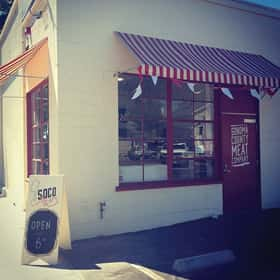 While many businesses that offer charcuterie products are affiliated with a restaurant—usually due to a desire by the chef to ensure product quality and add his or her own flair and style to these products—Sonoma County Meat Company in Santa Rosa started with the realization by co-owners Jenine Alexander and Rian Rinn that there was a “real need for meat processing facilities” for farmers in the North Bay and, at the same time, the demand for locally raised meat was growing.
While many businesses that offer charcuterie products are affiliated with a restaurant—usually due to a desire by the chef to ensure product quality and add his or her own flair and style to these products—Sonoma County Meat Company in Santa Rosa started with the realization by co-owners Jenine Alexander and Rian Rinn that there was a “real need for meat processing facilities” for farmers in the North Bay and, at the same time, the demand for locally raised meat was growing.“I knew a lot of livestock producers who were looking for a place to have their meat legally processed,” explains Rinn.
Though it took four and a half years of planning, a large initial investment and a mountain of paperwork, Rinn and Alexander decided to take a leap of faith and finally opened their doors in May of 2014 as Sonoma County’s only USDA inspected and Custom Exempt meat processing facility and smokehouse.
“With the growth of the big agricultural businesses, the majority of the infrastructure for processing local meat has evaporated—it’s just gotten run down or isn’t around anymore,” says Alexander. “When we started realizing the demand for locally raised meat and all the value-added products that go along with it, we thought, ‘Well heck, it’s jumping off a cliff, but we see the need and we’re going to hope that if we build it, they will come!’”
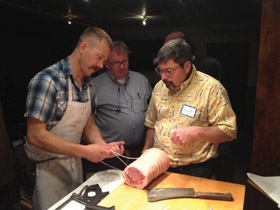 The pair almost equates opening a USDA plant to launching a hospital with the amount of equipment, machinery and infrastructure required, as well as the level of oversight by each government sector.
The pair almost equates opening a USDA plant to launching a hospital with the amount of equipment, machinery and infrastructure required, as well as the level of oversight by each government sector.“We’re working with every different governmental agency, from the farmers market to the city, county, state and the Feds,” says Alexander. “Every single department we have inspections from, either every day, every week, every month or every quarter. The Feds are here every day. There are a lot of pros to operating a USDA inspected meat plant. The biggest is knowing we’re providing a high quality product that’s locally produced and delicious, while at the same time protecting the public good and food safety with the protocols required by the USDA. The downside is all the paperwork, but there’s a reason for it.”
Not only does Sonoma County Meat Company produce its own dry cured, wet cured, pastured and non-pastured bacons and hams, it’s also a source for others, such as farmers reselling to grocery stores or at Farmers Markets, or hunters or individuals who raise animals for their own consumption, in making the best cured meats possible. In addition, Rinn, who besides being co-owner acts as head butcher, also offers classes to the public in everything from sausage making to curing bacons and hands-on half-hog butchering. Sausage makers can purchase casings of various sizes, pastured pork fat and other specialty items, and salami makers can obtain starter cultures at the shop.
Less than a year in business, Sonoma County Meat Company is selling its charcuterie products directly at its shop on Sebastopol Avenue in Santa Rosa, wholesale, and to other restaurants and retailers including Oliver’s Markets, Big John’s Market in Healdsburg, Estero Café, the Naked Pig, the Farmhouse Inn, Fogbelt Brewing Company, Spinster Sisters and several wineries. The enthusiasm of restaurants and retailers to carry its products speaks to the growing demand of not only locally raised meat, but those given high-quality feed and a high-quality life. By starting Sonoma County Meat Company, Rinn and Alexander hope to see a lot more small farms flourish throughout the North Bay.
“The role that we play is really symbiotic with the farmers, because their success is our success—and vice versa,” says Alexander. “We’re able to keep our prices low so they can make money on the animals they’re raising and can afford to continue living in Sonoma County.”
Sonoma County Meat Company’s goal is to continue to provide access to affordable meats with integrity—for the consumer, the farmer and for restaurants and retailers.


